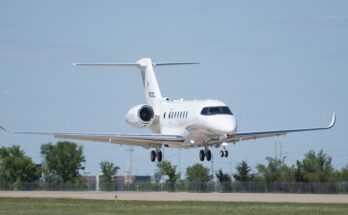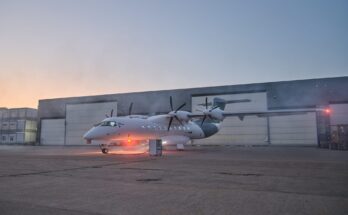Slow deliveries in August – orders mixed. Cathay Pacific books 30 A330-900s

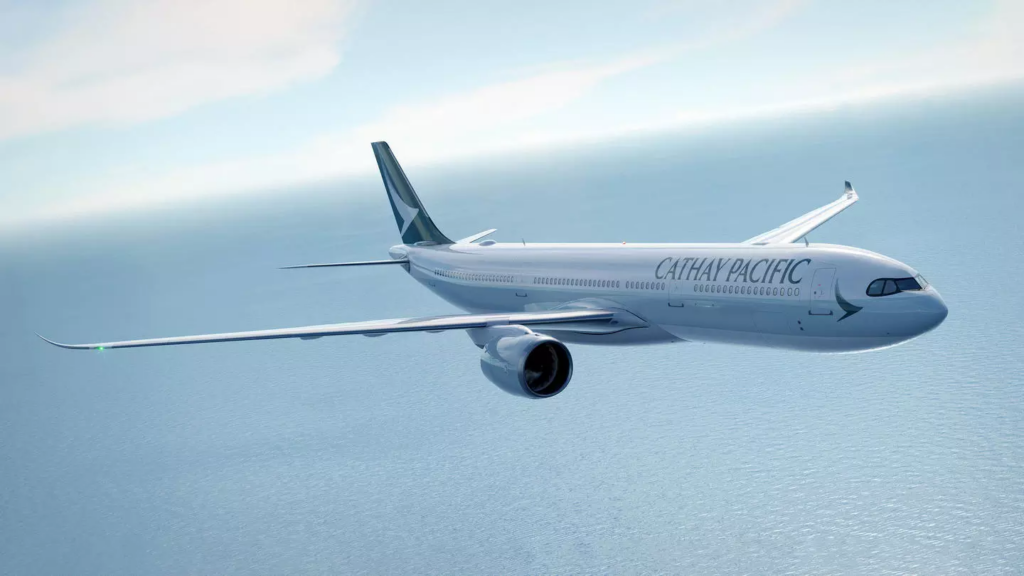
In August, deliveries were slow and orders mixed. On the orders front, the highlight was Cathay Pacifics order for 30 A330-900s. On the deliveries front, Boeing handed over 40 commercial jets (compared to 43 in July) while Airbus delivered 47 units, down from 77 last month. This compares to 35 deliveries for Boeing and 52 for Airbus in August of last year. Deliveries of the Boeing 737 MAX were 32 units in August unchanged from last month. Regulators have allowed Boeing to produce up to 38 737s per month, however, the company has opted to slow its production until it feels ready to return to the official production rate of 38 jets per month. With 34, 31 and 32 737 MAX’s shipped out in June, July, and August respectively, Boeing is still around 10-20% below the official rate.
Year-to-date, Boeing and Airbus have delivered 258 and 447 aircraft compared to 344 and 433, respectively, during the first eight months of 2023. As of August, Boeing is 86 deliveries behind compared to last year’s totals to date, while Airbus is 14 deliveries ahead. In 2023, in total, Boeing and Airbus delivered 528 and 735 aircraft compared to 480 and 663, respectively, in 2022. In 2023, Airbus won the deliveries crown for the fifth consecutive year.
Following a more than challenging 2020 due to the COVID-19 pandemic, 2021-23 were recovery years for the two largest commercial plane makers. Most likely, 2024 will be another year of recovery on the deliveries front followed by new records in 2025 and beyond. Boeing still has quite a way to go before setting new all-time company deliveries records, whereas Airbus will likely finish the year just below the pre-pandemic level. In 2018, before COVID-19 and the first 737 MAX grounding, Boeing delivered 806 jets, a level that will likely not be recaptured before the 2025-26 timeframe. Airbus’ record high of 863 shipments was set in 2019, a level that will likely be surpassed in 2025. Also, Airbus is expected to retain their deliveries lead for the foreseeable future due to the company’s comfortable backlog lead over its American rival. Before 2019, Boeing had out-delivered Airbus every year since 2012.
As indicated above, in August, Boeing delivered 40 jets, including 32 737s (all MAXs), one 767s, three 777, and four 787s. For most of last year, the 737 program was producing aircraft at an official rate of 31 per month. At the end of 2023, the program completed its transition to 38 aircraft per month. However, increased quality checks and audits by regulators in the aftermath of the Alaska Airlines Flight 1282 incident mean that Boeing is currently producing 737 MAXs at a lower rate. In March, Boeing Chief Financial Officer, Brian West, stated: “We are the ones who made the decision to constrain rates on the 737 program below 38 per month until we feel like we’re ready.” At the company’s second quarter earnings call in late July, Boeing announced it expects to return to its official production rate by the end of the year. With 34 737 MAX deliveries in June and another 31 in July and 32 in August, the company is making progress towards reaching this target (compared to the very low deliveries we saw in the beginning of the year). Boeing’s plans to increase production to approximately 50 737 MAX jets per month in the 2025/26 timeframe are still in effect. The target of 50 per month compares to the pre-crash/pre-pandemic rate of 52 737s per month in 2018. Last year, it was reported that the company is planning to boost production to 52 jets per month by January 2025. Boeing’s plan to open a new 737 MAX production line in Everett in the second half of 2024 has most likely been pushed well into 2025. The new line is in addition to the three lines currently in place at Renton. For now, in the aftermath of the Alaska Airlines Flight 1282 incident, the program will remain at 38 aircraft per month. The company is still producing 737 NGs but now only has 13 737-800s remaining in backlog – of which 11 are P-8 Poseidons for the U.S. Navy and allies – as well as an additional two 737-700s that will be converted into E-7A Airborne Early Warning and Control (AEW&C) aircraft for the U.S. Air Force.
The 787 program will be ramping up production next year. In January of this year, the 787 production rate was raised to five per month with a target of 10 per month by 2025/26. However, Boeing has for now reduced the 787 rate to four before returning to five by the end of the year.
The 767 program is currently producing jets at a rate of three units per month, a mix of KC-46 tankers (based on the 767-2C) and 767-300 freighters. The 777 program is currently pushing out aircraft at a rate of three per month. Most aircraft in backlog are 777 freighters, with only five 777-300ERs left. The 777 program was expected to get a new addition in late 2023 with the delivery of the first 777X, however, the 777X’s entry into service was postponed to 2025. Boeing recently reaffirmed the first delivery of the 777X will happen next year as planned. Boeing will also launch a new 777X-based freighter, thereby expanding its 777X and cargo portfolio. By the 2025/26 timeframe, Boeing expects to be delivering four 777s per month.
In August, Airbus delivered just 47 jets, including five A220s, 36 A320s (all NEO), one A330, and five A350s. On average, the company delivered 48 A320s per month in 2023 compared to 43 in 2022 and 44 year-to-date. Production is currently being increased, however, Airbus is no longer releasing their production rate changes and prefers to announce in what year they will reach a certain rate. At this time, we consider the unofficial A320 production rate to be 52 per month with further increases expected in the coming months. Airbus is working with its supply chain to increase A320 production to 75 aircraft per month by 2027. Previously, the target of 75 was expected to be reached in 2026, however, in late June, Airbus pushed the target out by a year as suppliers are simply unable to keep up with demand. Also, Airbus has reduced its 2024 deliveries target from 800 to 770. The A320 program was expected to reach a monthly rate of 65 by late 2024, however, while Airbus has not specified whether this target has also been pushed out, we would now not expect this level of production to be reached before well into 2025. The commercial aircraft fleet is getting a new addition this year with the entry-into-service of the A321XLR. Final assembly of the first production aircraft commenced in December 2023 with entry-into-service expected to take place in Q4 2024 (most likely October). On 19 July, Airbus announced that the A321XLR has received its EASA type certification. This fall, the first A321XLR production aircraft is set to roll of the production line for delivery to launch customer Iberia, which will use its first aircraft on transatlantic flights.
The A220, meanwhile, is being produced at an unofficial rate of seven aircraft per month (our estimated rate was raised from six to seven in July), with a monthly production rate of 14 expected by 2026. Airbus is reportedly considering to introduce a stretch version of the A220.
The A330 production rate was increased from two aircraft per month to three at the end of 2022, with an increase to four per month expected this year. The A350 production rate was raised to six per month at the end of 2023 in line with Airbus’ announcements. Airbus expects to produce 10 A350s per month by 2026 and 12 by 2028.
Turning to the August orders review, in terms of reported bookings, Boeing had a slow month and reported 22 gross orders from two different customers. Boeing reported a single cancellation in August (a 787), resulting in 21 net new orders. The largest order – by number of aircraft – was placed by Israel’s EL AL, which booked 20 737 MAX jets. The only other order in August was two 737-700 NGs for the U.S. Air Force. Boeing Defense, Space & Security (BDS) will later convert these aircraft to E-7A Wedgetail AEW&Cs. Year-to-date, Boeing has accumulated 207 net new orders (250 gross orders), compared to 510 net new orders (624 gross orders) after the first eight months of last year. Last year’s figures include Paris Air Show held in June 2023, where the general ordering activity was much stronger than at Farnborough this year. In 2023, Boeing booked a total of 1,314 net new orders (1,456 gross orders) – before ASC 606 changes – compared to 774 net new orders (935 gross orders) in 2022. Please note that for comparison reasons, we do not include Boeing’s so-called ASC 606 accounting adjustments in the numbers reported in this article and regard net new orders as gross orders minus cancellations.

In August, Airbus booked orders from three customers for a total of 46 jets (gross orders) and reported no cancellations. The largest order (by # of aircraft) for 30 A330-900s was placed by Cathay Pacific and significantly strengthens the A330 orderbook. Also, in August, airBaltic added 10 A220-300s to their fleet, which only consists of this type. Finally, a private customer booked three A320neos and three A350-900s. Year-to-date, Airbus has accumulated 432 gross orders (19 cancellations => 413 net new orders), compared to 1,218 net new orders (1,257 gross orders) after the first eight months of last year. In 2023, Airbus won the orders crown for the fifth consecutive year booking an astounding 2,094 net new orders (2,319 gross orders), compared to 820 net new orders (1,078 gross orders) in 2022.
At the end of August, Airbus reported a backlog of 8,564 jets, of which 7,627, or 89 percent, were A220 and A320ceo/neo family narrowbodies. Airbus’ all-time backlog record of 8,626 jets was set in March 2024. By the end of last month, Boeing’s backlog (total unfilled orders before ASC 606 adjustment) was 6,165 aircraft, of which 4,744, or 77 percent, were 737 NG/MAX narrowbody jets. Boeing’s all-time backlog record of 6,259 aircraft was, just like Airbus, set in March 2024. The number of Airbus aircraft to be built and delivered represents 9.9 years of shipments at the 2019 production level (the pre-pandemic level), or 11.7 years based on the 2023 total. In comparison, Boeing’s backlog would “only” last 7.7 years at the 2018 level (the most recent “normal” year for Boeing), or 11.7 years based on 2023 deliveries. Boeing’s book-to-bill ratio year-to-date, calculated as net new orders divided by deliveries, is 0.80 with Airbus coming in a bit higher at 0.92. This means that both manufacturers are currently tapping into their backlog. Boeing’s book-to-bill ratio last year was 2.49 with Airbus coming in even higher at 2.85. This means that both companies received well over two new firm orders for every aircraft delivered.
2024 Forecast
Forecast International’s Platinum Forecast System is a breakthrough in forecasting technology that provides 15-year production forecasts. The author has used the Platinum Forecast System to retrieve the latest delivery forecast data from the Civil Aircraft Forecast product. For 2024, Forecast International’s analysts currently expect Boeing and Airbus to deliver 413 and 764 commercial jets, respectively. Please note that these figures exclude militarized variants of commercial platforms such as Boeing’s P-8 Poseidon maritime patrol aircraft and KC-46 Pegasus tanker and Airbus’ A330 MRTT tanker.
In its current year guidance, Airbus expects to deliver 770 planes in 2024 (target reduced in June from 800), compared to 735 delivered in the previous year. Meanwhile, Boeing decided to forgo issuing a 2024 production forecast as it focuses on safety and quality improvements in the aftermath of the Alaska Airlines incident in January. Boeing reported results for the second quarter on July 31 and says it is on track to return to 38 737 MAXs per month by the end of the year. Airbus reported H1 2024 results on July 30 and reiterated its target to deliver 770 commercial jets this year.
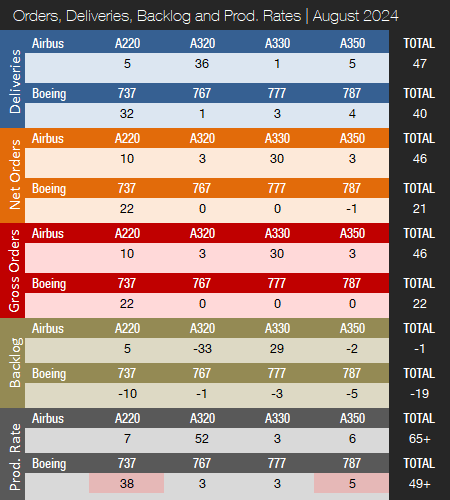
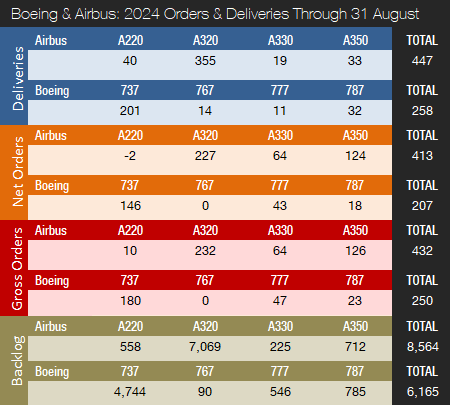
Note: Green color for production rates means the rate was just increased. Light red color means the program is temporarily producing at a lower rate than what is indicated in the table.
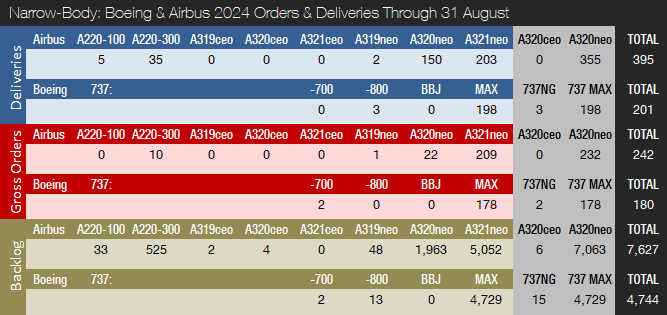
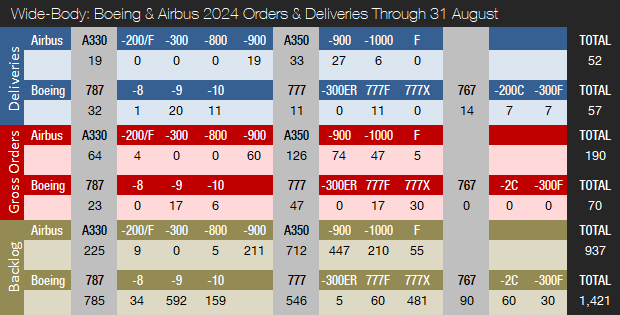
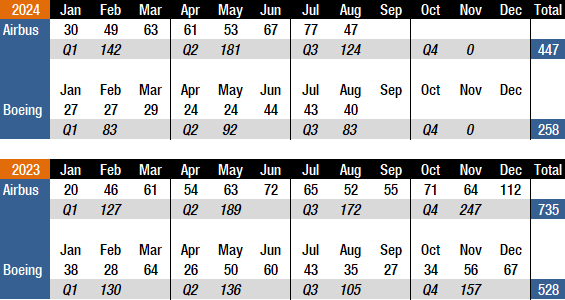
References:
- https://www.forecastinternational.com/platinum.cfm
- http://www.boeing.com/commercial/#/orders-deliveries
- https://www.airbus.com/aircraft/market/orders-deliveries.html
- https://boeing.mediaroom.com/2024-07-31-Boeing-Reports-Second-Quarter-Results
- https://boeing.mediaroom.com/2024-08-15-EL-AL-Israel-Airlines-Finalizes-Order-for-up-to-31-Boeing-737-MAX-Jets
- https://boeing.mediaroom.com/news-releases-statements?item=131475
- https://www.airbus.com/en/newsroom/press-releases/2024-07-airbus-reports-half-year-h1-2024-results-3265lkoi
- https://www.airbus.com/en/newsroom/press-releases/2024-06-airbus-provides-2024-guidance-update
- https://www.airbus.com/en/newsroom/press-releases/2024-08-cathay-group-orders-the-a330neo
- https://www.airbus.com/en/newsroom/press-releases/2024-08-airbaltic-places-order-for-10-additional-a220-aircraft-bringing
- https://www.reuters.com/business/aerospace-defense/first-airbus-a321xlr-delivery-due-second-half-october-airline-says-2024-09-20/
Kasper Oestergaard is an expert in aerospace & defense market intelligence, fuel efficiency in civil aviation, defense spending and defense programs. Mr. Oestergaard has a Master's Degree in Finance and International Business from the Aarhus School of Business - Aarhus University in Denmark. He has written four aerospace & defense market intelligence books as well as numerous articles and white papers about European aerospace & defense topics.

